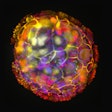
Researchers have developed a compact digital biosensor that can detect leaks in human cerebrospinal fluid (CSF) in as little as one second at the point of care. Details of the novel CSF test were published on February 1 in the Journal of Vacuum Science & Technology B.
The new test design, which uses a single-use sensor strip that is inserted into a circuit board with a four-digit readout, resembles a handheld glucometer and is powered by a 9-volt battery. The new device is faster and more sensitive than conventional methods for detecting CSF leaks, which typically require a clinical laboratory, can take hours or days to return results, and often fail to identify the specific leak site, according to the paper's authors, led by Minghan Xian of the University of Florida.
 Cerebrospinal fluid detection in action. The biosensor shows the inserted sensor strip and the four-digit readout. Image courtesy of Xian et al.
Cerebrospinal fluid detection in action. The biosensor shows the inserted sensor strip and the four-digit readout. Image courtesy of Xian et al.CSF is a watery fluid present in the brain and spinal cord that provides critical physiological functions, such as shock absorption and waste removal. CSF can sometimes leak out through the nose or ear after trauma or surgery, which can lead to life-threatening conditions such as meningitis and intracranial infection. Other causes of CSF leaks include congenital defects, obesity, high intracranial pressure, and obstructive sleep apnea.
The current gold standards for testing for CSF leaks include the enzyme-linked immunosorbent assay (ELISA) and immunofixation electrophoresis (IFE) testing. Both ELISA and IFE tests need to be processed at a clinical reference laboratory with trained personnel, may have long turnaround times, and may need to be further manipulated to be sensitive enough for ELISA or IFE to detect any abnormality, the authors wrote.
The new electrochemical sensor detects the biomarker beta-2-transferrin (B2T), a unique isomer of transferrin that is found in human CSF but no other bodily fluids.
To confirm that the sensor works, the researchers analyzed the samples of nine patient lumbar drains from the Neurological Intensive Care Unit at the University of Florida Health Shands Hospital. They compared the sensitivity of the sensor for detecting B2T when the samples were undiluted, diluted tenfold, and diluted hundredfold.
The results showed a positive correlation between all nine samples' B2T values and digital readouts from the circuit board even under the hundredfold dilution condition. Furthermore, compared to current ELISA tests, the electrochemical sensor's detection limit was five orders of magnitude lower at detecting the biomarker, the authors noted.
"We were surprised to find out that our detection method could not only provide the result within one second, but our detection limit was also a lot more sensitive for a very diluted concentration than existing detection methods," Xian said.
In future work, the researchers plan to focus on detecting various cancer and heart disease biomarkers, according to a press release.



















